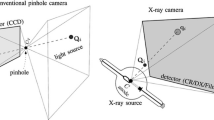Abstract
In medical radiography, a large area of the human body sometimes needs to be investigated by means of X-ray examinations, for example, the lower spine. With computed radiography (CR) cassettes, due to their large surface area, it is possible to make this type of investigation with a single exposure and use of a single cassette. With flat-panel digital detectors (DR detectors), due to their smaller size and their large cost, it is not possible to make the investigation with a single exposure, but multiple exposures are required according to the extent of the surface to be irradiated, with merging of two or more radiographic images. This operation is called “stitching” because several images are stitched together. We have tested three different modes of performing stitching examinations: linear, rotational and wide. Our purpose was to highlight the differences and issues, taking into account the quality of the images and the simplicity of use, with the goal of choosing the best technique. We evaluated the methods by three different parameters: the image quality, the ease of use (taking into account the time for performing an examination), and the simplicity of development. Each method has good qualities, but also its own problems: choosing the best technique is not easy, because each has advantages and disadvantages. Nowadays, rotational stitching is the most used because the quality of the images is very good and we are confident that the images have no parallax errors. However, this is not an easy system to develop because there are two different mechanical movements to be managed. For this reason, we are improving linear stitching, which is easier, but has a worse image quality. Wide stitching is the system closer to the CR system and has very good image quality, but the difficulty of developing a collimator that allows one to perform the technique presents a big hurdle. We conclude that, even though rotational stitching is complex and expensive, it is the best technique among those investigated.














Similar content being viewed by others
References
Gramer M, Bohlken W, Lundt B, Pralow T, Buzug T. An Algorithm for Automatic Stitching of CR X-ray Images. Adv Med Eng Springer Ser Proc Phys. 2007;114:193–8.
Gooßen A, Schlüter M, Hensel M, et al. Ruler-based automatic stitching of spatially overlapping radiographs. Informatik aktuell. 2008;10:192–6.
Supakul N, Newbrough K, Cohen MD, Jennings SG. Diagnostic errors from digital stitching of scoliosis images—the importance of evaluating the source images prior to making a final diagnosis. Pediatr Radiol. 2011;41:1–15.
Yaffe MJ, Rowlands JA. X-ray detectors for digital radiography. Phys Med Biol. 1997;42:1–39.
Wang L, Traub J, Weidert S, Heining SM, Euler E, Navab N. Parallax-free long bone X-ray image stitching. Med Image Comput Comput Assist Interv. 2009;12(Pt 1):173–80.
Wang L, Traub J, Weidert S, Heining SM, Euler E, Navab N. Parallax-free intra-operative X-ray image stitching. Med Image Anal. 2010;14(5):674–86.
Wang L, Traub J, Heining SM, Benhimane S, Euler E, Graumann R, Navab N. Long bone X-ray image stitching using Camera Augmented Mobile C-arm. Med Image Comput Comput Assist Interv. 2008;11(Pt 2):578–86.
Compagnone G, Baleni MC, Pagan L, et al. Comparison of radiation doses to patients undergoing standard radiographic examinations with conventional screen-film radiography, computed radiography and direct digital radiography. Br J Radiol. 2006;79:899–904.
Author information
Authors and Affiliations
Corresponding author
About this article
Cite this article
Bassi, S., Baldini, S., Rebuffat, C. et al. First test on three stitching methods with digital detectors used in radiography. Radiol Phys Technol 6, 187–196 (2013). https://doi.org/10.1007/s12194-012-0187-9
Received:
Revised:
Accepted:
Published:
Issue Date:
DOI: https://doi.org/10.1007/s12194-012-0187-9




